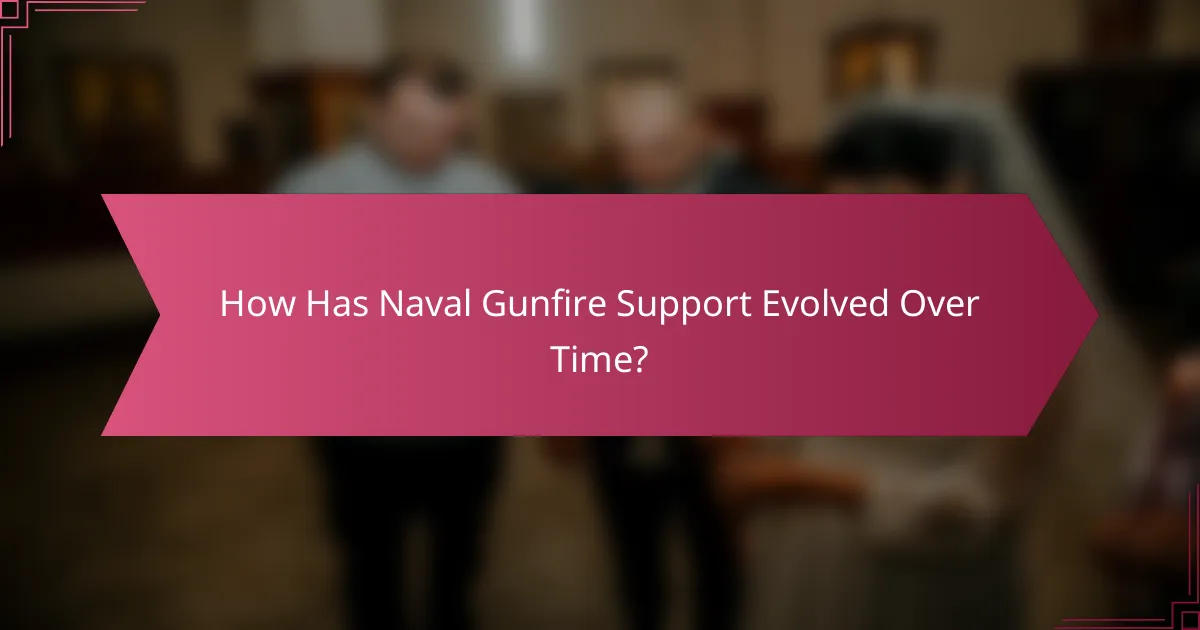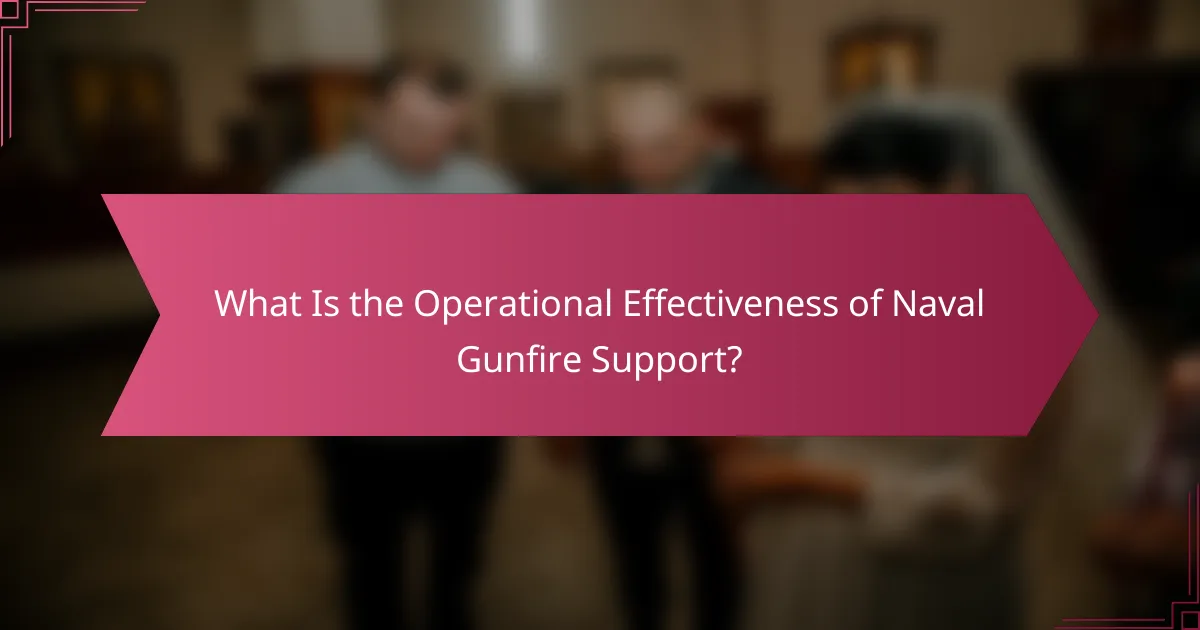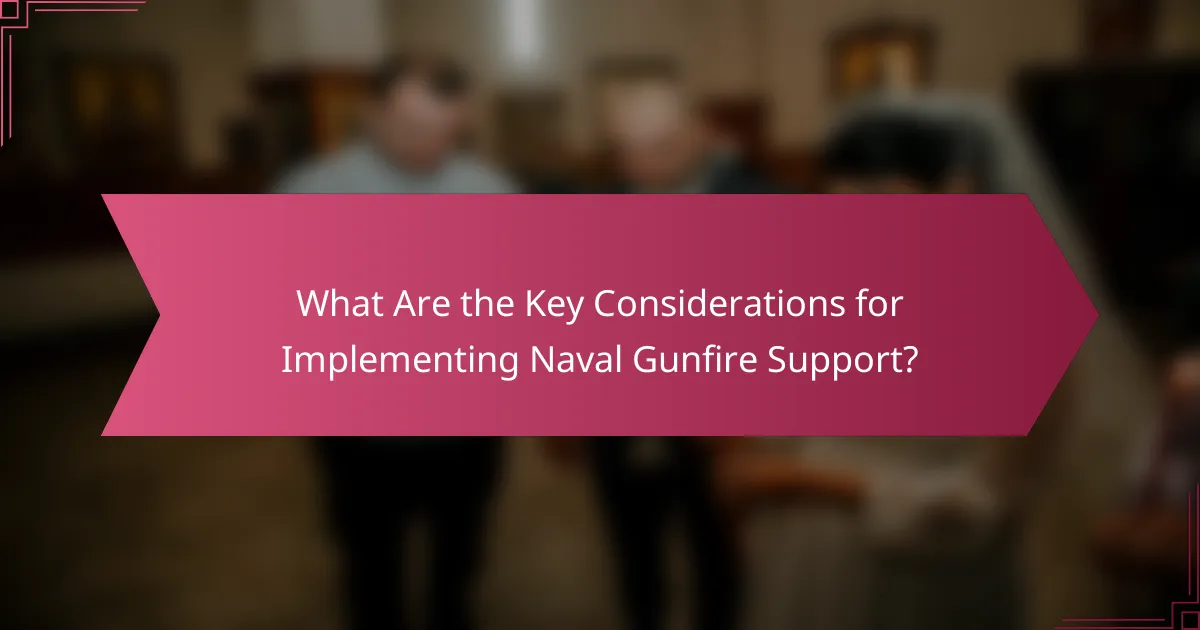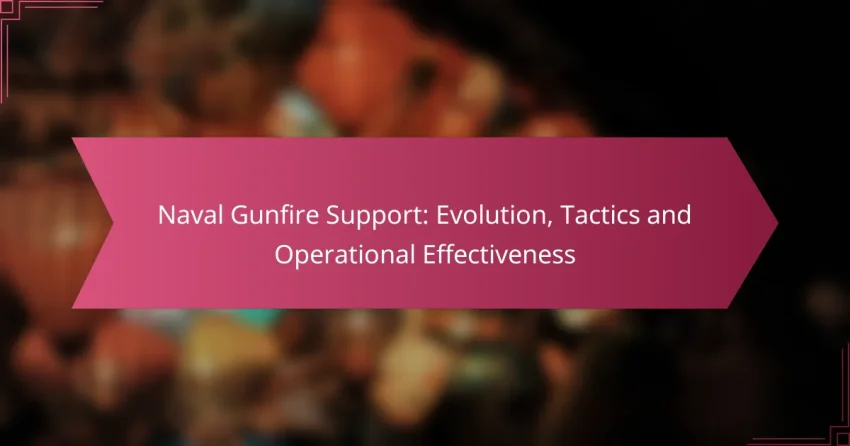Naval gunfire support (NGFS) has evolved from its traditional role in naval engagements to a vital element of contemporary military operations, driven by technological advancements and strategic shifts. Modern tactics emphasize precision and coordination with air and ground forces, aiming to maximize operational effectiveness while reducing collateral damage. This capability is essential for delivering timely and accurate firepower to support ground troops and influence battlefield dynamics.

How Has Naval Gunfire Support Evolved Over Time?
Naval gunfire support (NGFS) has transformed significantly from its early use in naval battles to a sophisticated component of modern military operations. This evolution reflects advancements in technology, changes in warfare strategies, and the development of specialized naval platforms.
Historical development
The origins of naval gunfire support date back to the Age of Sail, where ships used cannons to engage enemy vessels and provide support to ground troops. Over time, the introduction of steam power and ironclad ships in the 19th century marked a shift in naval tactics, allowing for more effective and sustained fire support.
During World War I and II, NGFS became a crucial element in amphibious assaults, with naval forces providing artillery support to ground troops during landings. The lessons learned in these conflicts laid the groundwork for modern NGFS tactics.
Key technological advancements
Technological progress has significantly enhanced the effectiveness of naval gunfire support. The introduction of radar and fire control systems improved targeting accuracy, allowing naval guns to engage targets with precision. Modern naval vessels are equipped with advanced computer systems that calculate firing solutions in real-time.
Additionally, the development of guided munitions, such as the GPS-guided Excalibur round, has increased the range and accuracy of naval gunfire, enabling ships to strike targets at distances exceeding 60 kilometers.
Influence of warfare changes
The nature of warfare has evolved, impacting how naval gunfire support is utilized. As conflicts have shifted towards asymmetric warfare and counterinsurgency operations, NGFS has adapted to support ground forces in urban and complex environments. This requires a focus on minimizing collateral damage while maximizing effectiveness.
Moreover, the integration of NGFS with joint operations has become essential, as naval forces work alongside air and ground units to provide comprehensive support in multi-domain operations.
Major conflicts shaping tactics
Key conflicts have shaped the tactics of naval gunfire support, notably the Vietnam War and the Gulf War. In Vietnam, naval forces provided extensive fire support to ground troops, leading to the development of more flexible and responsive NGFS tactics.
The Gulf War further demonstrated the effectiveness of precision-guided munitions in naval operations, prompting a shift towards more strategic use of naval gunfire in support of joint forces. These experiences have influenced current doctrine and training for naval gunfire support.
Notable naval platforms
Several naval platforms have become synonymous with effective gunfire support. The U.S. Navy’s Arleigh Burke-class destroyers are equipped with advanced Aegis combat systems and can deliver precision fire with their 5-inch guns.
Additionally, the Independence-class littoral combat ships feature modular designs that allow for rapid reconfiguration for various missions, including NGFS. These platforms highlight the ongoing evolution of naval capabilities to meet modern operational demands.

What Are the Current Tactics in Naval Gunfire Support?
Current tactics in naval gunfire support focus on precision, integration with air support, and coordination with ground forces. These tactics aim to enhance operational effectiveness while minimizing collateral damage and ensuring timely response to threats.
Close air support integration
Integrating close air support with naval gunfire enhances the overall effectiveness of military operations. By coordinating air and naval assets, forces can achieve greater precision in targeting and reduce the risk of friendly fire. This integration often involves real-time communication between naval and air units to ensure that targets are accurately identified and engaged.
For example, using forward air controllers (FACs) can streamline the process, allowing naval gunfire to complement air strikes effectively. This synergy is particularly crucial in urban environments where the risk of civilian casualties is heightened.
Fire support coordination
Fire support coordination is essential for maximizing the impact of naval gunfire while minimizing risks. This process involves planning and executing fire missions in conjunction with other forms of support, such as artillery and air strikes. Effective coordination ensures that all units are aware of each other’s capabilities and limitations.
Utilizing a fire support coordination center (FSCC) can facilitate this process, allowing for real-time adjustments based on battlefield dynamics. Regular training exercises that simulate joint operations can enhance the effectiveness of coordination efforts.
Targeting and engagement methods
Modern naval gunfire support employs advanced targeting and engagement methods to improve accuracy. Techniques such as laser designation and GPS-guided munitions allow for precise strikes on enemy positions. These methods significantly reduce the likelihood of collateral damage compared to traditional unguided munitions.
Additionally, the use of data links for real-time target updates enables naval forces to adapt quickly to changing battlefield conditions. This flexibility is crucial in dynamic environments where enemy positions may shift rapidly.
Joint operations with ground forces
Joint operations with ground forces are a cornerstone of effective naval gunfire support. Close collaboration between naval and ground units ensures that fire support is aligned with the overall mission objectives. This collaboration often involves shared intelligence and coordinated planning to optimize the use of naval assets.
For instance, establishing a clear chain of command and communication protocols can prevent misunderstandings and enhance operational efficiency. Regular joint training exercises can help build trust and improve coordination between naval and ground forces, ultimately leading to more successful missions.

What Is the Operational Effectiveness of Naval Gunfire Support?
The operational effectiveness of naval gunfire support (NGFS) refers to its ability to enhance mission success through precise and timely artillery fire from naval vessels. This capability is crucial for providing firepower in support of ground forces, disrupting enemy operations, and shaping the battlefield.
Impact on mission success
Naval gunfire support significantly impacts mission success by delivering accurate firepower to support ground troops in various combat scenarios. It can neutralize enemy positions, provide cover during troop movements, and assist in the destruction of critical infrastructure. The ability to coordinate NGFS with air and ground operations enhances overall effectiveness and reduces risks to friendly forces.
Effective communication and coordination between naval and ground forces are essential for maximizing the impact of NGFS. This ensures that artillery strikes are timely and aligned with the tactical needs of the mission, ultimately contributing to achieving operational objectives.
Metrics for effectiveness
Measuring the effectiveness of naval gunfire support involves several key metrics, including accuracy, response time, and the impact on enemy capabilities. Accuracy is often assessed by the percentage of rounds that hit within a designated target area, while response time refers to how quickly naval assets can engage targets after receiving a request for fire support.
Additionally, evaluating the reduction of enemy combat effectiveness and the subsequent achievement of mission objectives provides insight into the overall impact of NGFS. Tracking these metrics helps military planners refine tactics and improve future operations.
Case studies of successful operations
One notable case study is the use of naval gunfire support during the Gulf War, where U.S. Navy ships provided critical fire support to ground forces during the liberation of Kuwait. The precision and rapid response of naval artillery significantly contributed to the success of ground operations and minimized casualties.
Another example is the support provided during the Battle of Fallujah in Iraq, where naval gunfire was instrumental in suppressing enemy positions and enabling ground troops to advance. These case studies highlight the strategic importance of NGFS in modern warfare and its effectiveness in achieving tactical goals.

What Are the Key Considerations for Implementing Naval Gunfire Support?
Implementing naval gunfire support (NGFS) requires careful consideration of rules of engagement, environmental factors, and logistical challenges. Each of these elements plays a crucial role in ensuring effective and safe operations during naval engagements.
Rules of engagement
Rules of engagement (ROE) dictate the circumstances under which naval forces can engage in combat. These guidelines ensure that actions taken during operations comply with national and international laws, minimizing the risk of unintended consequences.
When planning for NGFS, commanders must clearly understand the ROE applicable to their mission. This includes identifying targets, assessing collateral damage, and ensuring that all personnel are trained on these rules to avoid violations that could lead to legal repercussions.
Environmental factors
Environmental factors significantly influence the effectiveness of naval gunfire support. Conditions such as weather, sea state, and visibility can affect the accuracy of gunfire and the safety of operations.
For instance, high winds and rough seas can lead to increased dispersion of projectiles, making targeting more challenging. Commanders should assess these conditions before engaging and consider postponing fire missions if the environment is unfavorable.
Logistical challenges
Logistical challenges in NGFS include the availability of ammunition, maintenance of equipment, and coordination with other military units. Ensuring that naval vessels are adequately supplied with the right types of munitions is critical for sustained operations.
Additionally, effective communication and coordination with ground forces and air support are essential to synchronize efforts and maximize operational effectiveness. Regular training exercises can help mitigate these logistical issues by improving readiness and response times during actual missions.

How Do Different Navies Utilize Gunfire Support?
Different navies employ gunfire support to enhance their operational effectiveness in various combat scenarios. This support typically involves naval vessels providing artillery fire to assist ground troops or engage enemy positions, with strategies tailored to each navy’s capabilities and mission objectives.
U.S. Navy approaches
The U.S. Navy utilizes gunfire support primarily through its fleet of guided missile destroyers and cruisers, which are equipped with advanced naval guns and missile systems. These vessels can deliver precise firepower to support ground forces, often coordinating with joint forces to maximize effectiveness.
In practice, U.S. Navy gunfire support involves detailed planning and real-time communication with ground units. This ensures that fire missions are accurately targeted, minimizing collateral damage while maximizing impact. The use of advanced targeting systems allows for rapid adjustments based on battlefield conditions.
Royal Navy strategies
The Royal Navy employs gunfire support through its Type 45 destroyers and other surface combatants, focusing on both precision and flexibility. These ships are equipped with the 4.5-inch gun, capable of engaging a variety of targets while providing essential support to ground operations.
Royal Navy strategies emphasize integration with air support and ground forces, ensuring that naval gunfire complements other forms of military action. Training exercises often simulate joint operations, allowing for seamless coordination during actual engagements. The Royal Navy also prioritizes the use of technology to enhance targeting accuracy and reduce response times.
